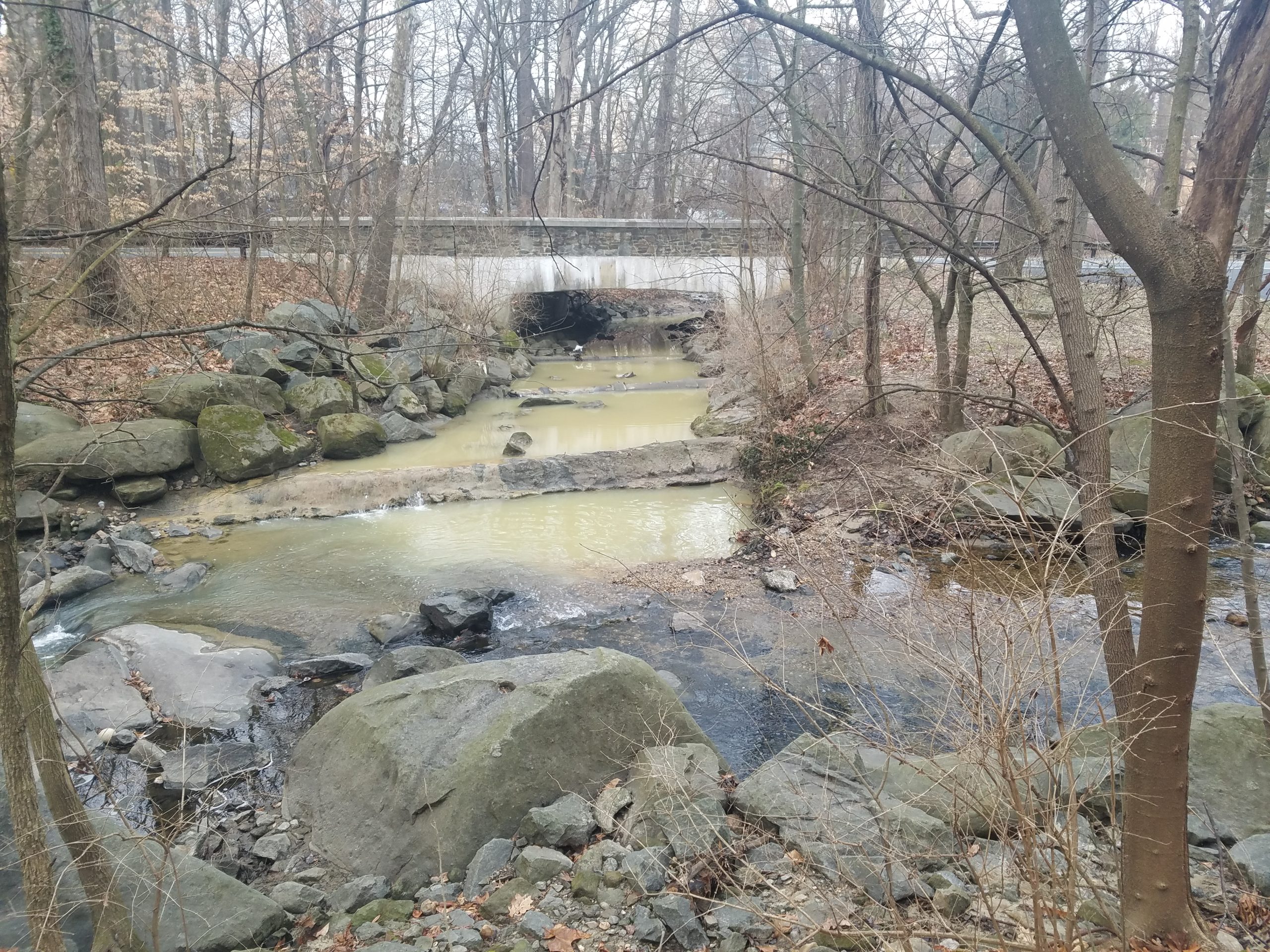Sligo Creek Water Quality Profile
Sligo Creek’s water quality is affected by its location in a heavily paved, urbanized area. High quality stream water is cool and rich in dissolved oxygen, on which fish and aquatic insects depend. It is relatively free of suspended materials such as sand or mud and toxic chemical inflows.
Presently, Sligo Creek’s temperature spikes during rainstorms as the heat, chemicals and other pollutants from roofs and parking lot surfaces are transferred to stormwater entering the creek. And this rapid runoff causes severe erosion to the stream bed, making the creek turbid with suspended sediment. Erosion also exposes adjacent sewer pipes, making them vulnerable to the force of the stream which can cause them to leak directly into the creek.
The best hope for reducing these problems affecting Sligo Creek’s water quality is the increased use of good stormwater management practices in the watershed, including using fewer impervious surfaces. A denser tree canopy would also help a lot because it manages and cools storm water that enters the Creek. It also provides needed nutrients for our waterway.

Sediment pollution flowing from Brashears Run into Sligo Creek, including two partially exposed sewer pipes (Photo by Dean Tousley)
USGS Data
The US Geological Survey reports basic water quality indicators on a real time basis from one monitoring stations along Sligo Creek. The USGS data can be found here.
Prior to June 30, 2010, the U.S. Geological Survey maintained a stream gauge on the Northwest Branch, less than a mile downstream of Sligo Creek. Friends of Sligo Creek keeps historical records of breaches recorded at this gauge.
The Water Quality Committee Chairperson Dean Tousley can be contacted at [email protected].
Summary Comparison of Sligo Creek Water Quality with Maryland State Use 1 Standards
The table below compares Sligo Creek with Maryland state standards for Use I Waters (i.e., freshwater bodies allowing for water contact recreation, protection of aquatic life, and public water supply.) Sligo Creek is designated a Use I stream by the Maryland Department of Environmental Protection.
| Parameter | Maryland State Standard | Sligo Creek |
|---|---|---|
| Temperature | Less than 32.2° C (90° F) at any time | Meets standard |
| Turbidity | May not exceed levels detrimental to aquatic life; turbidity resulting from discharges may not exceed 150 units at any time or 50 units as a monthly average. | Turbidity standard breached during stormwater events |
| Bacteria | Steady state geometric mean indicator density: Enterococci bacteria ≤33 E. coli bacteria ≤126 Maximum allowable density for infrequent full body contact recreation: Enterococci bacteria = 151 E. coli bacteria = 576 |
Sligo sites usually exceed standard levels |
| pH | Never less than 6.5 or greater than 8.5 at any time | pH standard sometimes breached |
| Dissolved Oxygen | Never less than 5 mg/L at any time | Meets standard |
Table Parameters: Temperature, Turbidity, pH, and Dissolved Oxygen
The Maryland state standard for dissolved oxygen for Use I waters such as Sligo Creek is never less than 5 mg/liter at any time. Sligo Creek’s main stem dissolved oxygen readings have not been observed to be below 5 mg/liter.
Maps of historical stream quality conditions – Benthic Macroinvertebrates
Sligo Creek Water Quality – Historical Materials
- On July 4, 2004, the Montgomery County Department of Environmental Protection’s Assessment for Wheaton Branch and Main Stem single day snapshot study reported an oxygen reading of 4.63 mg/liter for Wheaton Branch.
- A government-contracted study published in 1998 found that:
“Of the three major tributaries surveyed, Wheaton Branch exhibited the lowest baseflow dissolved oxygen (DO) levels. Violations of Maryland Department of the Environment’s (MDE) 5.0 mg/L DO criteria were recorded at Wheaton Branch on four out of the 30 sampling dates (5/23/94, 6/18/94, 6/22/94, and 6/9/95). The lowest stream DO concentration observed during the study 2.87 mg/L, was recorded on 6/18/94 approximately 250 meters downstream of the Wheaton Branch stormwater management facility (SWM). While some aquatic can tolerate low dissolved oxygen levels (or even anaerobic conditions) for show periods, concentrations of 6.0 mg/L or higher are often required for long term survival.”¹
- Benthic Macroinvertebrates: Sligo Creek received a poor rating at all tested sites based on surveys of bottom dwelling stream insects in 2004, 2006, and 2008 for the Maryland Stream Waders program. This means that the population of bottom dwelling aquatic non-backboned creatures was found to be lacking in variety and abundance, and that few types of pollution-sensitive macroinvertebrates were found in Sligo Creek. Sligo Creek similarly received a poor rating in earlier macroinvertebrate surveys.
- Pesticides: The U.S. Geological Survey sampled Sligo Creek for pesticides in August 1994. The concentrations of pesticides found in the single sample didn’t break any known Environmental Protection Agency standards, but little is known about the effects of pesticide mixtures. View this evaluation of pesticide levels in Sligo Creek.
¹ Cummins, James D., Stribling, James B., and Galli, John. Biological Responses to Stream Habitat Rehabilitation in the Sligo Creek Watershed, Montgomery County, Maryland, December 1998 : Chemical, Physical, and Biological Monitoring Results from 1 Year Pre-Restoration to 2 Years Post-Restoration. Prepared for the Maryland Department of the Environment and the Montgomery Department of Environmental Protection. Interstate Commission on the Potomac River Basin Publication Number ICPRB-97-3, pg. 12.







